Shi-Xiong Zhang
T1: A Tool-Oriented Conversational Dataset for Multi-Turn Agentic Planning
May 22, 2025Abstract:Large Language Models (LLMs) have demonstrated impressive capabilities as intelligent agents capable of solving complex problems. However, effective planning in scenarios involving dependencies between API or tool calls-particularly in multi-turn conversations-remains a significant challenge. To address this, we introduce T1, a tool-augmented, multi-domain, multi-turn conversational dataset specifically designed to capture and manage inter-tool dependencies across diverse domains. T1 enables rigorous evaluation of agents' ability to coordinate tool use across nine distinct domains (4 single domain and 5 multi-domain) with the help of an integrated caching mechanism for both short- and long-term memory, while supporting dynamic replanning-such as deciding whether to recompute or reuse cached results. Beyond facilitating research on tool use and planning, T1 also serves as a benchmark for evaluating the performance of open-source language models. We present results powered by T1-Agent, highlighting their ability to plan and reason in complex, tool-dependent scenarios.
Continual Pre-training of MoEs: How robust is your router?
Mar 06, 2025Abstract:Sparsely-activated Mixture of Experts (MoE) transformers are promising architectures for foundation models. Compared to dense transformers that require the same amount of floating point operations (FLOPs) per forward pass, MoEs benefit from improved sample efficiency at training time and achieve much stronger performance. Many closed-source and open-source frontier language models have thus adopted an MoE architecture. Naturally, practitioners will want to extend the capabilities of these models with large amounts of newly collected data without completely re-training them. Prior work has shown that a simple combination of replay and learning rate re-warming and re-decaying can enable the continual pre-training (CPT) of dense decoder-only transformers with minimal performance degradation compared to full re-training. In the case of decoder-only MoE transformers, however, it is unclear how the routing algorithm will impact continual pre-training performance: 1) do the MoE transformer's routers exacerbate forgetting relative to a dense model?; 2) do the routers maintain a balanced load on previous distributions after CPT?; 3) are the same strategies applied to dense models sufficient to continually pre-train MoE LLMs? In what follows, we conduct a large-scale (>2B parameter switch and DeepSeek MoE LLMs trained for 600B tokens) empirical study across four MoE transformers to answer these questions. Our results establish a surprising robustness to distribution shifts for both Sinkhorn-Balanced and Z-and-Aux-loss-balanced routing algorithms, even in MoEs continually pre-trained without replay. Moreover, we show that MoE LLMs maintain their sample efficiency (relative to a FLOP-matched dense model) during CPT and that they can match the performance of a fully re-trained MoE at a fraction of the cost.
WorldCuisines: A Massive-Scale Benchmark for Multilingual and Multicultural Visual Question Answering on Global Cuisines
Oct 16, 2024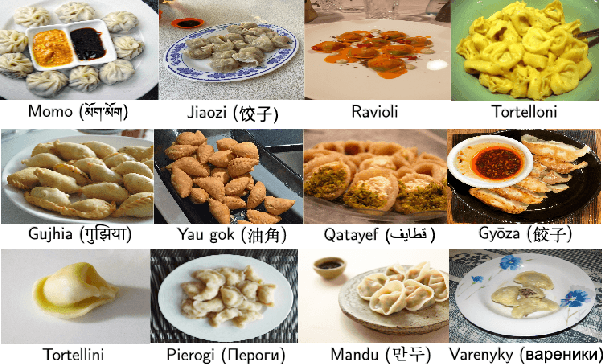

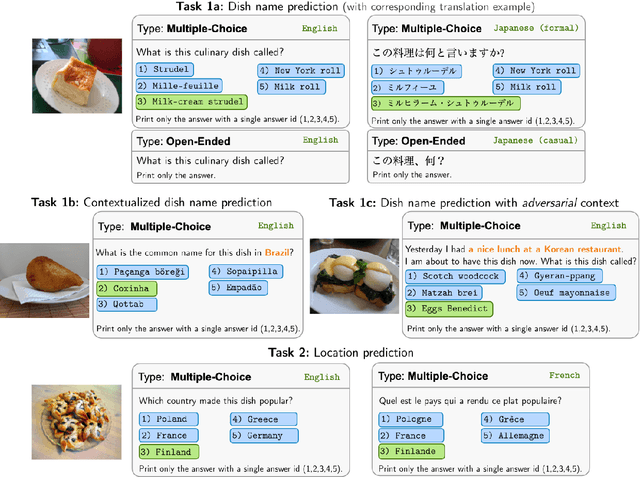

Abstract:Vision Language Models (VLMs) often struggle with culture-specific knowledge, particularly in languages other than English and in underrepresented cultural contexts. To evaluate their understanding of such knowledge, we introduce WorldCuisines, a massive-scale benchmark for multilingual and multicultural, visually grounded language understanding. This benchmark includes a visual question answering (VQA) dataset with text-image pairs across 30 languages and dialects, spanning 9 language families and featuring over 1 million data points, making it the largest multicultural VQA benchmark to date. It includes tasks for identifying dish names and their origins. We provide evaluation datasets in two sizes (12k and 60k instances) alongside a training dataset (1 million instances). Our findings show that while VLMs perform better with correct location context, they struggle with adversarial contexts and predicting specific regional cuisines and languages. To support future research, we release a knowledge base with annotated food entries and images along with the VQA data.
RainbowPO: A Unified Framework for Combining Improvements in Preference Optimization
Oct 05, 2024



Abstract:Recently, numerous preference optimization algorithms have been introduced as extensions to the Direct Preference Optimization (DPO) family. While these methods have successfully aligned models with human preferences, there is a lack of understanding regarding the contributions of their additional components. Moreover, fair and consistent comparisons are scarce, making it difficult to discern which components genuinely enhance downstream performance. In this work, we propose RainbowPO, a unified framework that demystifies the effectiveness of existing DPO methods by categorizing their key components into seven broad directions. We integrate these components into a single cohesive objective, enhancing the performance of each individual element. Through extensive experiments, we demonstrate that RainbowPO outperforms existing DPO variants. Additionally, we provide insights to guide researchers in developing new DPO methods and assist practitioners in their implementations.
Preference Tuning with Human Feedback on Language, Speech, and Vision Tasks: A Survey
Sep 17, 2024



Abstract:Preference tuning is a crucial process for aligning deep generative models with human preferences. This survey offers a thorough overview of recent advancements in preference tuning and the integration of human feedback. The paper is organized into three main sections: 1) introduction and preliminaries: an introduction to reinforcement learning frameworks, preference tuning tasks, models, and datasets across various modalities: language, speech, and vision, as well as different policy approaches, 2) in-depth examination of each preference tuning approach: a detailed analysis of the methods used in preference tuning, and 3) applications, discussion, and future directions: an exploration of the applications of preference tuning in downstream tasks, including evaluation methods for different modalities, and an outlook on future research directions. Our objective is to present the latest methodologies in preference tuning and model alignment, enhancing the understanding of this field for researchers and practitioners. We hope to encourage further engagement and innovation in this area.
LibriheavyMix: A 20,000-Hour Dataset for Single-Channel Reverberant Multi-Talker Speech Separation, ASR and Speaker Diarization
Sep 01, 2024



Abstract:The evolving speech processing landscape is increasingly focused on complex scenarios like meetings or cocktail parties with multiple simultaneous speakers and far-field conditions. Existing methodologies for addressing these challenges fall into two categories: multi-channel and single-channel solutions. Single-channel approaches, notable for their generality and convenience, do not require specific information about microphone arrays. This paper presents a large-scale far-field overlapping speech dataset, crafted to advance research in speech separation, recognition, and speaker diarization. This dataset is a critical resource for decoding ``Who said What and When'' in multi-talker, reverberant environments, a daunting challenge in the field. Additionally, we introduce a pipeline system encompassing speech separation, recognition, and diarization as a foundational benchmark. Evaluations on the WHAMR! dataset validate the broad applicability of the proposed data.
Comparing Discrete and Continuous Space LLMs for Speech Recognition
Sep 01, 2024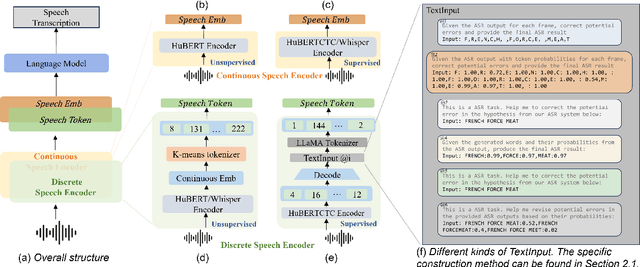
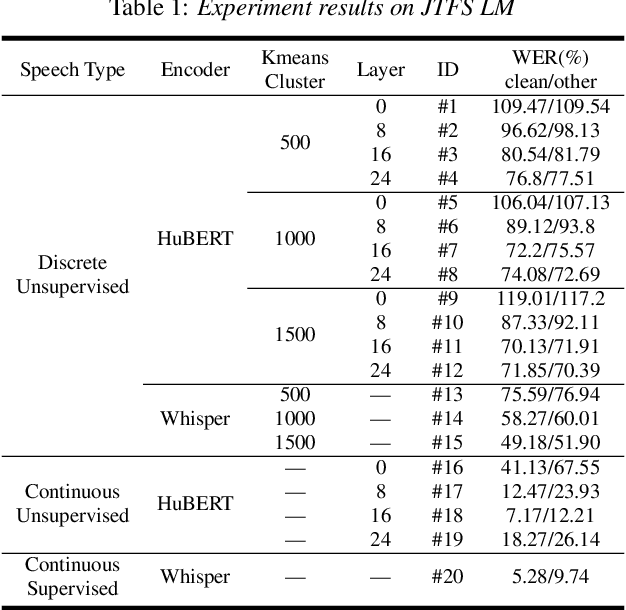
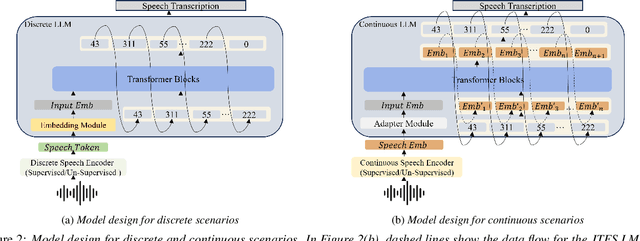
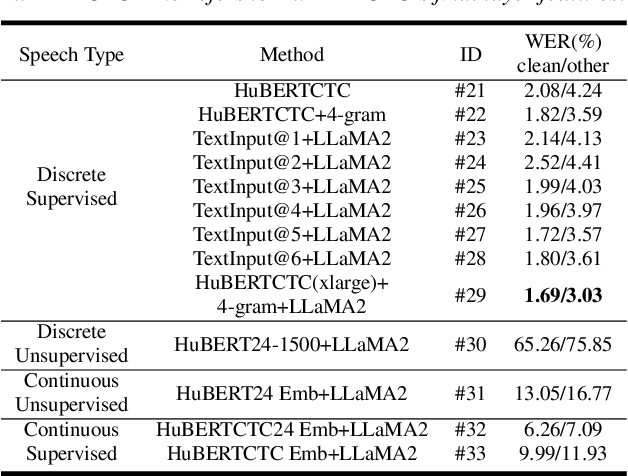
Abstract:This paper investigates discrete and continuous speech representations in Large Language Model (LLM)-based Automatic Speech Recognition (ASR), organizing them by feature continuity and training approach into four categories: supervised and unsupervised for both discrete and continuous types. We further classify LLMs based on their input and autoregressive feedback into continuous and discrete-space models. Using specialized encoders and comparative analysis with a Joint-Training-From-Scratch Language Model (JTFS LM) and pre-trained LLaMA2-7b, we provide a detailed examination of their effectiveness. Our work marks the first extensive comparison of speech representations in LLM-based ASR and explores various modeling techniques. We present an open-sourced achievement of a state-of-the-art Word Error Rate (WER) of 1.69\% on LibriSpeech using a HuBERT encoder, offering valuable insights for advancing ASR and natural language processing (NLP) research.
Advancing Multi-talker ASR Performance with Large Language Models
Aug 30, 2024



Abstract:Recognizing overlapping speech from multiple speakers in conversational scenarios is one of the most challenging problem for automatic speech recognition (ASR). Serialized output training (SOT) is a classic method to address multi-talker ASR, with the idea of concatenating transcriptions from multiple speakers according to the emission times of their speech for training. However, SOT-style transcriptions, derived from concatenating multiple related utterances in a conversation, depend significantly on modeling long contexts. Therefore, compared to traditional methods that primarily emphasize encoder performance in attention-based encoder-decoder (AED) architectures, a novel approach utilizing large language models (LLMs) that leverages the capabilities of pre-trained decoders may be better suited for such complex and challenging scenarios. In this paper, we propose an LLM-based SOT approach for multi-talker ASR, leveraging pre-trained speech encoder and LLM, fine-tuning them on multi-talker dataset using appropriate strategies. Experimental results demonstrate that our approach surpasses traditional AED-based methods on the simulated dataset LibriMix and achieves state-of-the-art performance on the evaluation set of the real-world dataset AMI, outperforming the AED model trained with 1000 times more supervised data in previous works.
Multi-Channel Multi-Speaker ASR Using Target Speaker's Solo Segment
Jun 17, 2024Abstract:In the field of multi-channel, multi-speaker Automatic Speech Recognition (ASR), the task of discerning and accurately transcribing a target speaker's speech within background noise remains a formidable challenge. Traditional approaches often rely on microphone array configurations and the information of the target speaker's location or voiceprint. This study introduces the Solo Spatial Feature (Solo-SF), an innovative method that utilizes a target speaker's isolated speech segment to enhance ASR performance, thereby circumventing the need for conventional inputs like microphone array layouts. We explore effective strategies for selecting optimal solo segments, a crucial aspect for Solo-SF's success. Through evaluations conducted on the AliMeeting dataset and AISHELL-1 simulations, Solo-SF demonstrates superior performance over existing techniques, significantly lowering Character Error Rates (CER) in various test conditions. Our findings highlight Solo-SF's potential as an effective solution for addressing the complexities of multi-channel, multi-speaker ASR tasks.
RIR-SF: Room Impulse Response Based Spatial Feature for Multi-channel Multi-talker ASR
Oct 31, 2023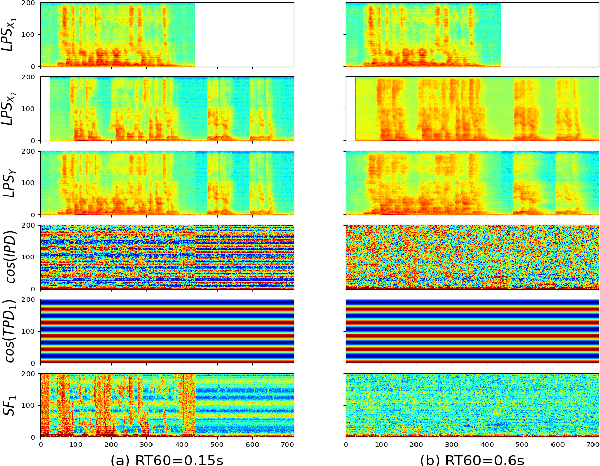

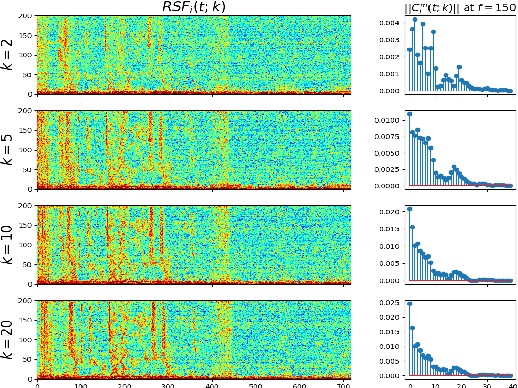
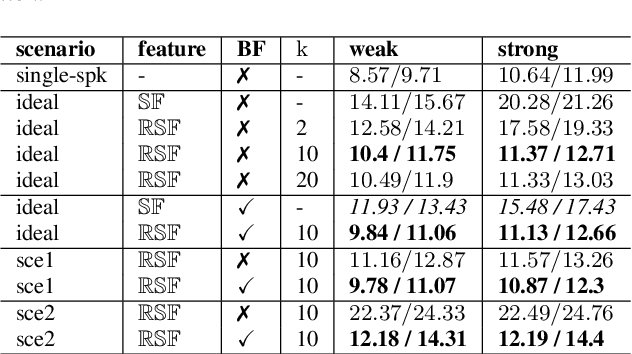
Abstract:Multi-channel multi-talker automatic speech recognition (ASR) presents ongoing challenges within the speech community, particularly when confronted with significant reverberation effects. In this study, we introduce a novel approach involving the convolution of overlapping speech signals with the room impulse response (RIR) corresponding to the target speaker's transmission to a microphone array. This innovative technique yields a novel spatial feature known as the RIR-SF. Through a comprehensive comparison with the previously established state-of-the-art 3D spatial feature, both theoretical analysis and experimental results substantiate the superiority of our proposed RIR-SF. We demonstrate that the RIR-SF outperforms existing methods, leading to a remarkable 21.3\% relative reduction in the Character Error Rate (CER) in multi-channel multi-talker ASR systems. Importantly, this novel feature exhibits robustness in the face of strong reverberation, surpassing the limitations of previous approaches.
 Add to Chrome
Add to Chrome Add to Firefox
Add to Firefox Add to Edge
Add to Edge